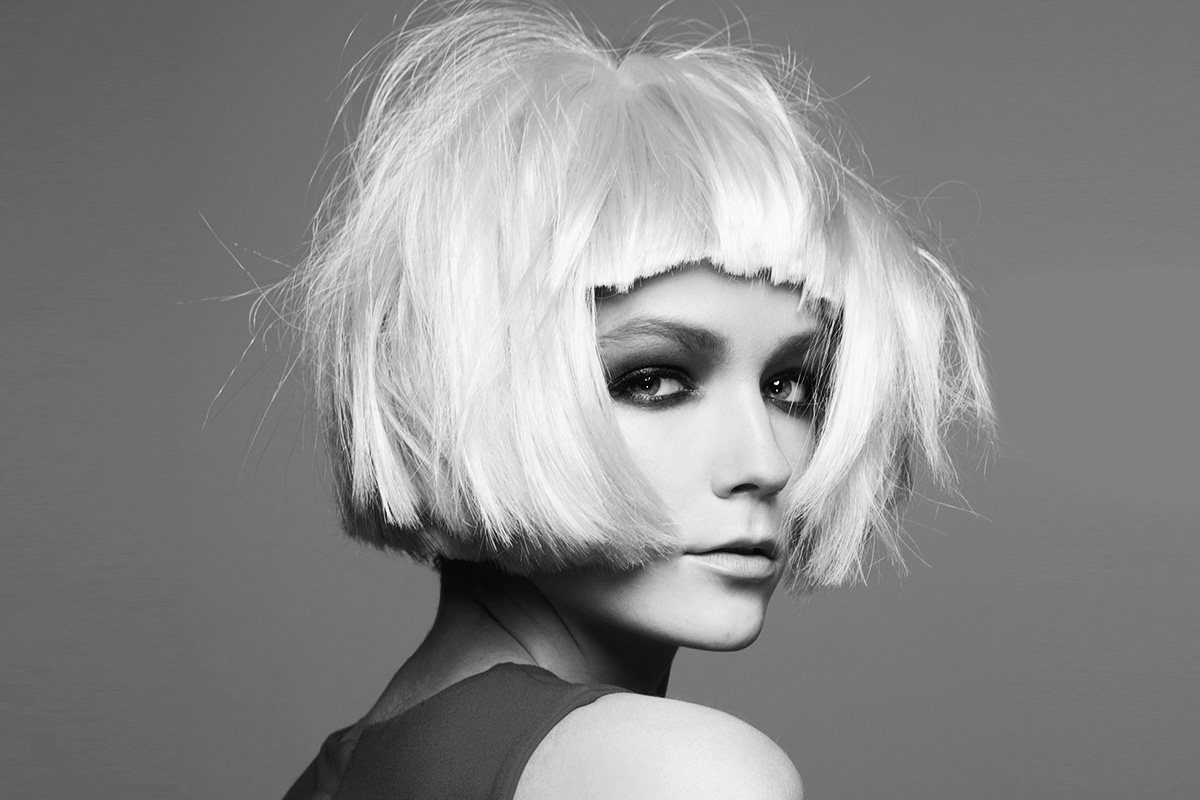Alopecia in a client: what does a hairdresser need to know?
And how to act
2019-07-12

Alopecia is an unpleasant pathological disease that hairdressers, stylists and colorists encounter from time to time in their work. We learned from experts what to do in this situation, what to pay attention to the client and how to camouflage problem areas of the head.
Alopecia is a pathological hair loss, leading to its partial or complete disappearance in certain areas of the head or torso. If you notice that your client's hair shafts have become brittle and weak, hair is pulled out with the slightest effort, it has become dull, unhealthy-looking and tangled, and more than 15 hairs are falling out per comb, this may indicate alopecia. In this material, together with technologist and developer of cosmetics Yulia Gagarina, we decided to figure out how care can affect hair loss and what components can be directly involved in this process. And international class hairdresser Irina Zaitseva was asked which doctor a client with suspected baldness should be sent to, how to camouflage problem areas of the head, and what haircuts should be chosen for alopecia in women. 
 What remedies help in the treatment of alopecia and how to select them? Cosmetics cannot cure alopecia, but there are cosmetic ingredients that have been proven to both prevent baldness and promote hair growth. The most effective complexes: Redensyl. It includes: Water, Glycerin, Sodium Metabisulfite, Glycine, Larix Europaea Wood Extract, Zinc Chloride, Camellia Sinensis Leaf Extract. Procapil. It includes: Butylene Glycol, Aqua, PPG-26-Buteth-26, PEG 40 Hydrogenated Castor Oil, Apigenin, Oleanolic Acid, Biotinoyl Tripeptide-1. Darkenyl. It includes: Taxifolin Glucoside, N-Acetyl Tyrosine. Taxifolin Glycoside is a stabilized antioxidant that stimulates the proliferation and maintenance of stem cells. ACB Bio-Chelate 5 PF. It includes: Water & Saccharomyces/ Zinc Ferment & Saccharomyces/ Copper Ferment & Saccharomyces/ Magnesium Ferment & Saccharomyces/ Iron Ferment & Saccharomyces/ Silicon Ferment & Saccharomyces. This probiotic mineral complex works to strengthen hair structure rather than enhance growth.
What remedies help in the treatment of alopecia and how to select them? Cosmetics cannot cure alopecia, but there are cosmetic ingredients that have been proven to both prevent baldness and promote hair growth. The most effective complexes: Redensyl. It includes: Water, Glycerin, Sodium Metabisulfite, Glycine, Larix Europaea Wood Extract, Zinc Chloride, Camellia Sinensis Leaf Extract. Procapil. It includes: Butylene Glycol, Aqua, PPG-26-Buteth-26, PEG 40 Hydrogenated Castor Oil, Apigenin, Oleanolic Acid, Biotinoyl Tripeptide-1. Darkenyl. It includes: Taxifolin Glucoside, N-Acetyl Tyrosine. Taxifolin Glycoside is a stabilized antioxidant that stimulates the proliferation and maintenance of stem cells. ACB Bio-Chelate 5 PF. It includes: Water & Saccharomyces/ Zinc Ferment & Saccharomyces/ Copper Ferment & Saccharomyces/ Magnesium Ferment & Saccharomyces/ Iron Ferment & Saccharomyces/ Silicon Ferment & Saccharomyces. This probiotic mineral complex works to strengthen hair structure rather than enhance growth. 

Yulia Gagarina , chemist, technologist and developer of cosmetics
Can the composition of cosmetic products for hair and scalp cause hair loss? What ingredients should you avoid? Anything that causes inflammation can cause hair loss. In care products, the main provocateurs of inflammation are detergents, preservatives, dyes and fragrances. If the detergent base is harsh (that is, it washes well, but causes inflammation of the scalp and disruption of the hair structure), this can provoke hair loss. Such compositions must be rinsed very thoroughly (at least 7.5 liters of water are required per soaping). Among the detergent “pests”: Sodium Lauryl Sulfate, Sodium Laureth Sulfate, Ammonium Lauryl Sulfate, Cetrimonium Chloride, Cocamide DEA. For hair loss, it is better to use products with mild detergent ingredients. Among the sulfate-free ones: Laureth-7 Citrate, Disodium Lauryl Sulfosuccinate, Sodium Cocoyl Isethionate, Sodium Cocoyl Sarcosinate, Sodium Lauroyl Methyl Isethionate, Sodium Methyl Cocoyl Taurate, Sodium Laureth-13 Carboxylate. Soft sulfate surfactants include: Sodium Myreth Sulfate, Sodium Coco Sulfate. Ideally, the detergent base should be extensive. The more detergent components, the fewer side effects from the shampoo. Preservatives with a high sensitization index can also provoke hair loss due to inflammation of the skin. Among them: Methylisothiazolinone, Methylchloroisothiazolinone, Bromo-2-nitropropane-1,3-diol. What remedies help in the treatment of alopecia and how to select them? Cosmetics cannot cure alopecia, but there are cosmetic ingredients that have been proven to both prevent baldness and promote hair growth. The most effective complexes: Redensyl. It includes: Water, Glycerin, Sodium Metabisulfite, Glycine, Larix Europaea Wood Extract, Zinc Chloride, Camellia Sinensis Leaf Extract. Procapil. It includes: Butylene Glycol, Aqua, PPG-26-Buteth-26, PEG 40 Hydrogenated Castor Oil, Apigenin, Oleanolic Acid, Biotinoyl Tripeptide-1. Darkenyl. It includes: Taxifolin Glucoside, N-Acetyl Tyrosine. Taxifolin Glycoside is a stabilized antioxidant that stimulates the proliferation and maintenance of stem cells. ACB Bio-Chelate 5 PF. It includes: Water & Saccharomyces/ Zinc Ferment & Saccharomyces/ Copper Ferment & Saccharomyces/ Magnesium Ferment & Saccharomyces/ Iron Ferment & Saccharomyces/ Silicon Ferment & Saccharomyces. This probiotic mineral complex works to strengthen hair structure rather than enhance growth.
What remedies help in the treatment of alopecia and how to select them? Cosmetics cannot cure alopecia, but there are cosmetic ingredients that have been proven to both prevent baldness and promote hair growth. The most effective complexes: Redensyl. It includes: Water, Glycerin, Sodium Metabisulfite, Glycine, Larix Europaea Wood Extract, Zinc Chloride, Camellia Sinensis Leaf Extract. Procapil. It includes: Butylene Glycol, Aqua, PPG-26-Buteth-26, PEG 40 Hydrogenated Castor Oil, Apigenin, Oleanolic Acid, Biotinoyl Tripeptide-1. Darkenyl. It includes: Taxifolin Glucoside, N-Acetyl Tyrosine. Taxifolin Glycoside is a stabilized antioxidant that stimulates the proliferation and maintenance of stem cells. ACB Bio-Chelate 5 PF. It includes: Water & Saccharomyces/ Zinc Ferment & Saccharomyces/ Copper Ferment & Saccharomyces/ Magnesium Ferment & Saccharomyces/ Iron Ferment & Saccharomyces/ Silicon Ferment & Saccharomyces. This probiotic mineral complex works to strengthen hair structure rather than enhance growth. 
Irina Zaitseva , international class master, president of the Education For Life foundation, ex-president of Intercoiffure Ukraine
What should a hairdresser do if he sees signs of alopecia in a client? It is worth paying attention to this problem politely and correctly. The client may think this is normal hair loss. Be sure to recommend visiting a trichologist, since the treatment of alopecia is a medical aspect, not a hairdressing one. How to camouflage problem areas of girls' heads? First, you should style it, and then apply a camouflage spray in areas where sparse hair is noticeable. Its shade may be one tone darker than your hair color. What haircuts and hairstyles should you pay attention to in this case? You should pay attention to medium length haircuts. Variations on the bob theme are still relevant. Avoid contrasts.Read also
- Causes of baldness in men: a trichologist explains
- Step-by-step technology for bright coloring 2019
- Educational literature for stylist
- The Art of Body Art: An Interview with Bella Valen
- Nude Glam Rock: rebellious collection from NB SCHOOL
- How to create wet makeup: step-by-step technology with photos
- The Open qualifying round of the Ukrainian Championship in hairdressing, nail aesthetics and makeup took place in Druzhkovka